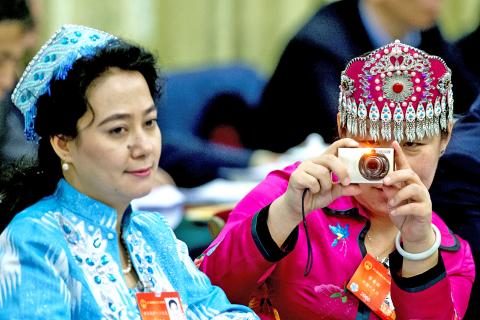Loyal to the core and prized for their horsemanship, several thousand Manchu soldiers heeded the emperor’s call and, with families and livestock in tow, embarked in 1764 on a trek that took them from northeastern China to the most distant fringes of the Qing dynasty empire, the Central Asian lands now known as Xinjiang.
It was an arduous, 18-month journey, but there was one consolation: After completing their mission of pacifying the western frontier, the troops would be allowed to take their families home.
“They were terribly homesick here and dreamed of one day going back east,” said Tong Hao, 56, a descendant of the settlers, from the Xibe branch of the Manchus, who arrived here emaciated and exhausted. “But sadly, it was not to be.”

Photo: AP/Alexander Yuan
ETHNOGRAPHIC ODDITY
But two-and-a-half centuries later, the roughly 30,000 people in this rural county who consider themselves Xibe have proved to be an ethnographic curiosity and a linguistic bonanza. As the last handful of Manchu speakers in northeast China have died, the Xibe have become the sole inheritors of what was once the official tongue of one of the world’s most powerful empires, a domain that stretched from India to Russia and formed the geographic foundation for modern China.
In the decades after the revolution in 1911 that drove the Qing from power after nearly 300 years, Mandarin Chinese vanquished the Manchu language, even in its former stronghold in the forested northeast. But the isolation of the Xibe in this parched, far-flung region near the Kazakh border helped keep the language alive, even if its existence was largely forgotten until the 1940s.
For scholars of Manchu, especially those eager to translate the mounds of Qing dynasty documents that fill archives across China, the discovery of so many living Manchu speakers has been a godsend.
“Imagine if you studied the classics and went to Rome, spoke Latin and found that people there understood you,” said Mark Elliott, a Manchu expert at Harvard University who said he remembered his first encounter, in 2009, with an older Xibe man on the streets of Qapqal county. “I asked the guy in Manchu where the old city wall was, and he didn’t blink. It was a wonderful encounter, one that I’ll never forget.”
Despite the local government’s best efforts, which include language instruction in primary schools and the financing of a biweekly newspaper, what is known here as Xibe is facing the common fate of many of the world’s languages: declining numbers of speakers and the prospect of extinction.
DYING TONGUES
The publication Ethnologue identifies almost 300 living languages in China, half of them on the edge of the abyss as Mandarin, the nation’s official language, continues to subsume minority tongues. Among those under pressure, 20 have fewer than 1,000 speakers, according to the Web site The World of Chinese.
Although many young people here still speak Xibe at home, few of them can read its graphically bold script, made up of 121 letters and written vertically, from left to right. One recent day in the offices of The Qapqal News, a four-page gazette composed mostly of articles translated from the state-run news media, He Wenjun, 72, a teacher and translator, said he worried that his children and grandchildren could not read or write Xibe.
“Language is not only a tool for communication, but it ties us to who we are and makes us feel close to one another,” said He, who has spent decades translating imperial Qing documents into Chinese. “I wonder how much longer our mother tongue can survive.”
Even as intermarriage and migration to other parts of the country dilute their identity, the Xibe remain proud of their history and especially their role helping to secure the lands that greatly expanded China’s borders. It was a Manchu emperor who tapped the Xibe to settle the Ili Valley here after Qing soldiers massacred or exiled the nomads who had long menaced the empire’s western borderlands.
In the decades that followed, a succession of rebellions, many of them led by the region’s ethnic Uighurs, kept the Xibe garrisons busy and sometimes thinned their ranks. One battle in 1867 nearly halved the Xibe population, to 13,000.
Until the 1970s, the Xibe remained isolated from the ethnic Kazakhs and Uighurs who settled Ghulja, a city that sits on the far side of the Ili River. The Xibe also ate pork and practiced a blend of shamanism and Buddhism, making intermarriage with the Muslim Kazakhs and Uighurs relatively rare.
“We happily lived in our own world and rarely took boats to the other side of the river,” said Tong Zhixian, 61, a retired forestry official who sings and performs traditional Xibe dances at the county’s new history museum.
“We fought with the other groups, but there were so few of us here and no one else spoke our language, so we had to learn theirs to survive,” said Tong, an engineer at the county power company who is vice president of the Xibe Westward March Culture Study Association, a local group that promotes Xibe language and history. “That’s why we are so good at learning foreign languages.”
Those linguistic talents have long been an asset to China’s leaders. In the 1940s, young Xibe were sent north to study Russian, and they later served as interpreters for the newly victorious Communists. In recent years, the government has brought Xibe speakers to Beijing to help decipher the sprawling Qing archives, many of them of imperial correspondence that few scholars could read.
“If you know Xibe, it takes no time for you to crack the Qing documents,” said Zhao Zhiqiang, 58, one of six students from Qapqal county sent to the capital in 1975, and who now heads the Manchu study department at the Beijing Academy of Social Sciences. “It’s like a golden key that opens the door to the Qing dynasty.”

Under pressure, President William Lai (賴清德) has enacted his first cabinet reshuffle. Whether it will be enough to staunch the bleeding remains to be seen. Cabinet members in the Executive Yuan almost always end up as sacrificial lambs, especially those appointed early in a president’s term. When presidents are under pressure, the cabinet is reshuffled. This is not unique to any party or president; this is the custom. This is the case in many democracies, especially parliamentary ones. In Taiwan, constitutionally the president presides over the heads of the five branches of government, each of which is confusingly translated as “president”

Sept. 1 to Sept. 7 In 1899, Kozaburo Hirai became the first documented Japanese to wed a Taiwanese under colonial rule. The soldier was partly motivated by the government’s policy of assimilating the Taiwanese population through intermarriage. While his friends and family disapproved and even mocked him, the marriage endured. By 1930, when his story appeared in Tales of Virtuous Deeds in Taiwan, Hirai had settled in his wife’s rural Changhua hometown, farming the land and integrating into local society. Similarly, Aiko Fujii, who married into the prominent Wufeng Lin Family (霧峰林家) in 1927, quickly learned Hoklo (commonly known as Taiwanese) and

The low voter turnout for the referendum on Aug. 23 shows that many Taiwanese are apathetic about nuclear energy, but there are long-term energy stakes involved that the public needs to grasp Taiwan faces an energy trilemma: soaring AI-driven demand, pressure to cut carbon and reliance on fragile fuel imports. But the nuclear referendum on Aug. 23 showed how little this registered with voters, many of whom neither see the long game nor grasp the stakes. Volunteer referendum worker Vivian Chen (陳薇安) put it bluntly: “I’ve seen many people asking what they’re voting for when they arrive to vote. They cast their vote without even doing any research.” Imagine Taiwanese voters invited to a poker table. The bet looked simple — yes or no — yet most never showed. More than two-thirds of those

In the run-up to the referendum on re-opening Pingtung County’s Ma-anshan Nuclear Power Plant last month, the media inundated us with explainers. A favorite factoid of the international media, endlessly recycled, was that Taiwan has no energy reserves for a blockade, thus necessitating re-opening the nuclear plants. As presented by the Chinese-language CommonWealth Magazine, it runs: “According to the US Department of Commerce International Trade Administration, 97.73 percent of Taiwan’s energy is imported, and estimates are that Taiwan has only 11 days of reserves available in the event of a blockade.” This factoid is not an outright lie — that